STUDYIN

Mastering Machine Gun Tactics Quiz
Test your knowledge on machine gun tactics and various military concepts with this comprehensive quiz. Covering topics such as firing methods, defensive strategies, and engineering roles in combat, this quiz is designed for both aspiring and seasoned military personnel.
Features:
- 29 challenging questions
- Multiple choice format
- Focus on practical military applications
__________ are developed to aid MG units in acquiring targets quickly to support a ground SOM?
Minimum safe lines
Target reference points
Principle directions of fire
Final protective lines
Which fires are the most desirable machine gun class of fire with respect to the target?
Flanking Fire
Frontal Fire
Enfilade Fire
Oblique Fire
Which of the following are classifications of machinegun fires in relation to the target?
Dead Space, Danger Space, Plunging Fire, Grazing Fire
Fixed, Traversing, Searching, Traversing and Searching, Swinging Traverse, Free Gun
Flanking Fire, Frontal Fire, Oblique Fire, Enfilade Fire
Plunging Fire, Grazing Fire, Flanking Enfilade Fire, Frontal Enfilade Fire
In defensive operations, which of the following is NOT a way the M18A1 claymore munition is utilized?
As a protective obstacle
Reinforce other obstacles
Disrupt combat formations
Clear minefields and obstacles
When loading the PLD, what technique would be used in a night attack to provide the platoon commander the most security to the front but limits the ability to command and control?
Combination of crow’s foot and bent-L
Crow’s foot
Bent-L
None of the above
What are the five essential elements of an offensive scheme of maneuver?
Main Effort, Type of Attack, TCMs, Sequence of Events, and Consolidation Plan.
Commanders Intent, Scheme of Maneuver, FSP, Tasks, and Coordinating Instructions.
Distribution of Forces, Checkpoints, Objective, CASEVAC Plan, and Consolidation.
Distribution of Forces, Form of Maneuver, Direction of Attack, TCMs, and Consolidation.
What is the proper sequence for the three elements of a breaching organization to commence actions?
Support force, breach force, assault force
Suppression force, support force, breach force
Obscuration force, support force, breach force
Support force, security force, assault force
The following is a type of fire control measure for MGs in the offense:
Final protective line
Trigger line
Minimum safe line
Line of departure
What are the two methods that can be given to machineguns in a MORT statement?
Final protective lines; Principal direction of fire
By unit; Echelon
By stealth; By force
Bent-L method; Crow’s foot
Which acronym is used to identify the principles of machine gun employment?
MORT
HAW, MAW, LAW
PICMDEEP
ENFILADE
What four functions does engineers provide on the battlefield?
Obstacles, Breaching, Defense, Explosives
Mobility, Counter-Mobility, Survivability, General Engineering
Breaching, Minefield Operations, Force Protection, General Engineering
Mobility, Obstacle Plans, Survivability, General Engineering
What are the two methods of occupying a support by fire position?
Crow’s foot and Bent-L
By stealth and by force
Infiltration and by fire
Covert and overt
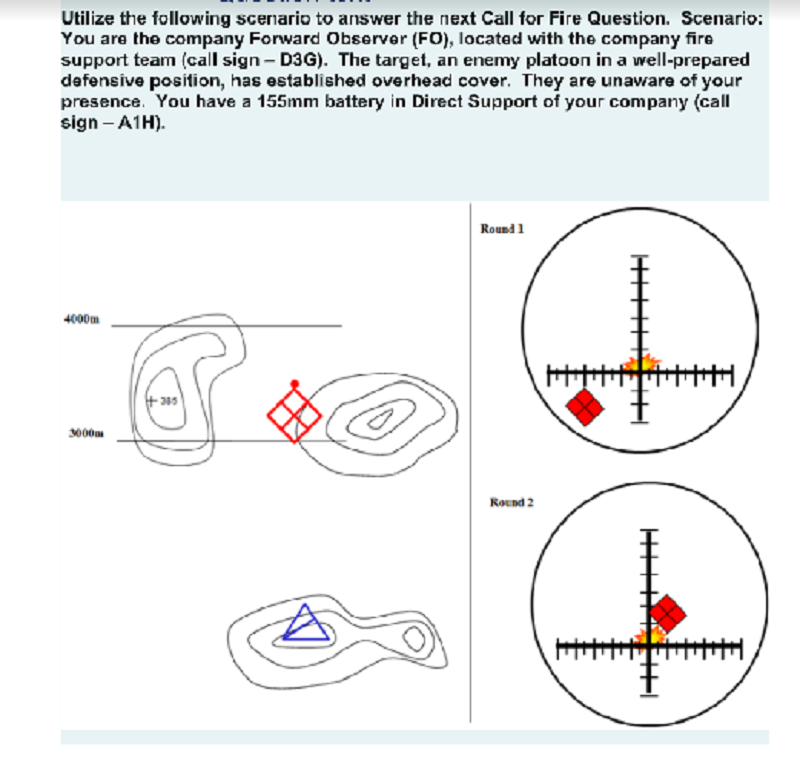
You observe Round 1 impact and spot the round. Using bracketing and your binoculars, what is the appropriate correction you will send to the FDC?
�Left 90, drop 200, over.”
�Left 90, drop 400, over.”
�Left 30, drop 400, over.”
�Left 30, drop 200, over.”
As an artillery forward observer (FO) adjusting fire during a polar mission, you make the following spotting: “Over, 40 Right.” Based on the following information, what correction will you transmit to the fire direction center (FDC)? OT distance: 3600 meters OT direction: 1430 mils
R120, +200, over
R160, +400, over
L120, -200, over
L160, -400, over
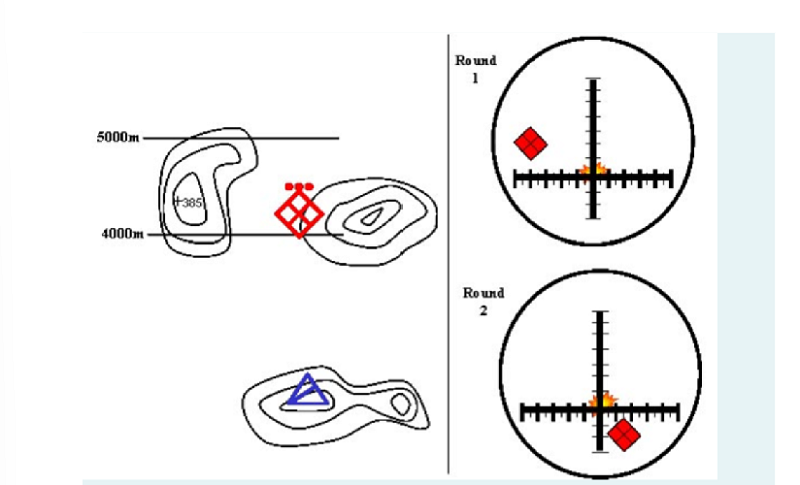
What is your observer-to-target (OT) factor, and to which portion of the spotting (range or deviation) do you multiply this number by?
4.5; deviation
5; range
4; deviation
4; deviation
A(n) _______________ is an area in which specific firing or coordination restrictions are imposed and into which fires in excess that exceeds those restrictions will not be delivered without coordination with the establishing headquarters.
No Fire Area (NFA)
Restrictive Fire Area (RFA)
Coordinated Firing Line (CFL)
Battle Position
Combat engineers support offensive and defensive operations over a spectrum of four functional areas. Select the best example of combat engineers in the offense and defense conducting counter-mobility operations.
Improving and maintaining lines of communication and main supply routes. Emplacing obstacles that divide the enemy’s forces just prior to the engagement area.
Using blocking obstacles to deny the enemy access to advancing units’ flanks or rear. Laying an anti-vehicle obstacle belt along a mounted enemy’s likely avenue of approach.
Construction and maintenance of expeditionary airfields. Reinforcing command posts and combat support positions.
Providing bridging equipment to facilitate river crossings. Clearing landing zones for resupply and medical evacuation missions.
Which answer best identifies elements of a comprehensive defensive scheme of maneuver?
Type/Method of Defense, Distribution of Forces, Orientation, Occupation Plan, TCMs, Security Plan.
Distribution of Forces, Form of Maneuver, Direction of Attack, TCMs, and Consolidation.
ORP, Checkpoints, Location of the Defense, Priorities of Work, Security
Preparation, Flexibility, Depth
In the defense, a platoon should never go below _____ security at any time.
25%
50%
75%
100%
In the defense, listening posts/observation posts (LP/OPs) can be used to ___________.
Observe enemy movement and report to the platoon commander.
Call for fire on enemy units.
Identify and prepare supplementary positions while marking TRP’s and direct fire control measures.
Observe enemy movement and report to the platoon commander and call for fire on enemy units.
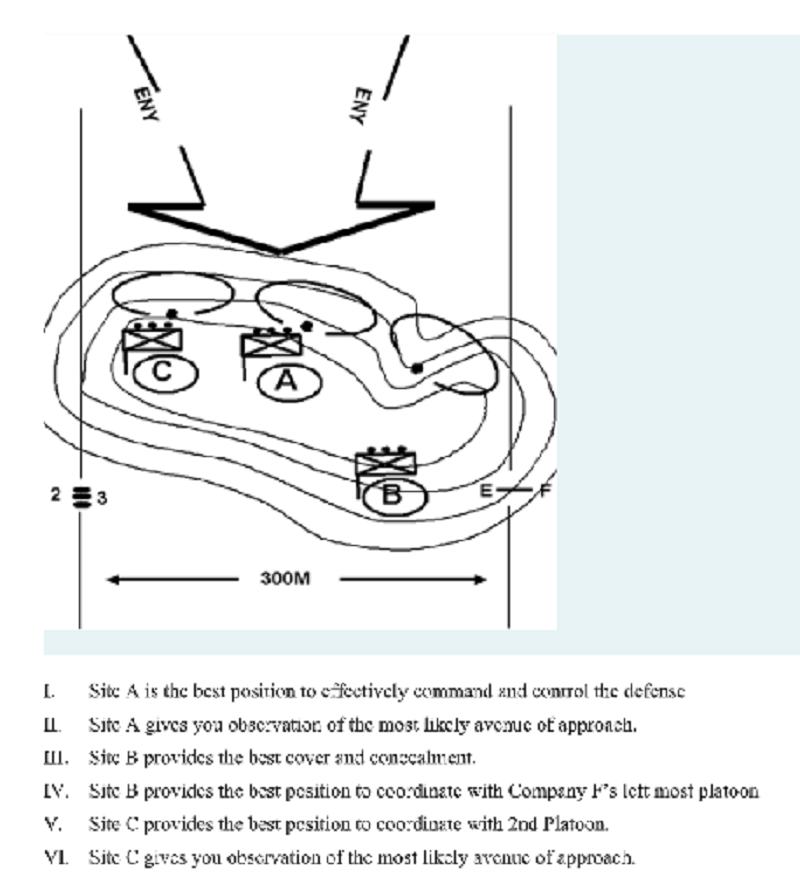
You decide on site ______ for your CP because of ______ above.
A; I and II
B; III
B; III and IV
C; V and VI
What are four methods a platoon commander utilizes to control his/her fires in the defense?
Trigger line, target reference point, engagement criteria, target precedence
Obstacles, early warning devices, FPF, PDF
FPF, PDF, FSP, TRP
FPF, PICMDEEP, ADDRAC, turning obstacles
What allows the commander to visually depict the effects of his engagement area and prevent gaps in his/her fires?
Fire plan sketch
Leader’s recon where TRP’s are marked
LP/OPs and patrols
IDF targets used to cover gaps and dead space
In the defense, a machine gun’s principle direction of fire seeks to achieve what type of fires in relation to the enemy?
Flanking Enfilade
Frontal Enfilade
Plunging
Plunging
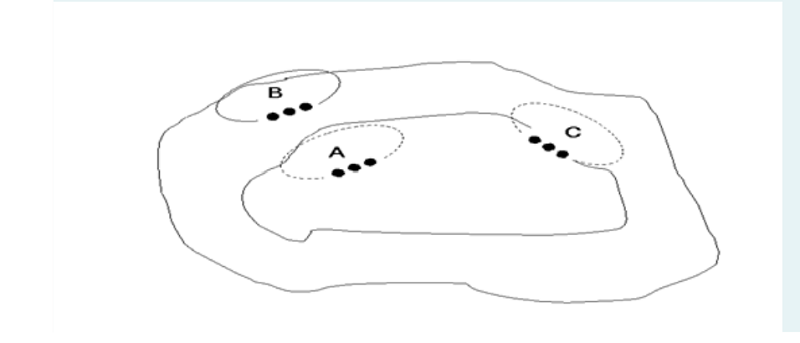
Use the picture below to identify the specified features.
A(n) __________ orients on retention of terrain by absorbing the enemy in an interlocking series of positions and destroying him largely by fires.
Area Defense
Mobile Defense
Retrograde
Withdrawal
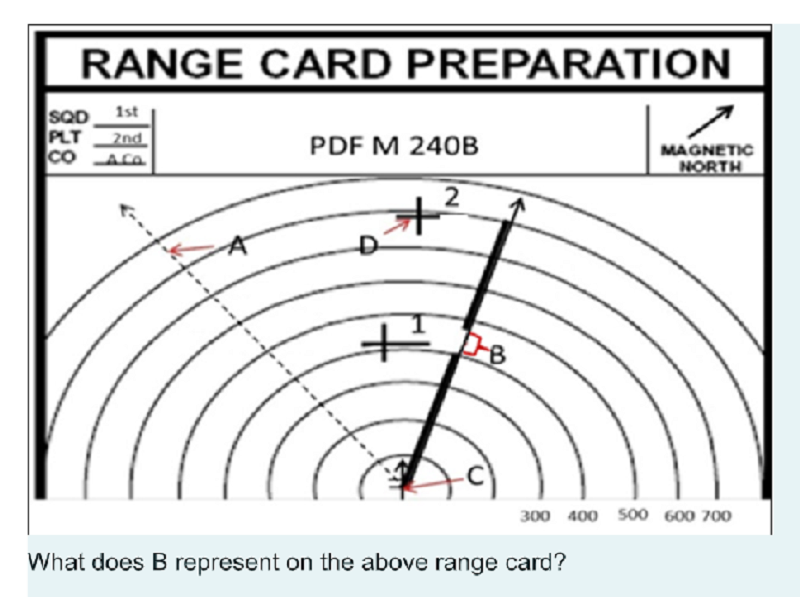
What does B represent on the above range card?
Lateral Limit
Final Protective Fires
Dead Space
Gun position
Matching Test Items: Select the Description that best matches the Support Relationship. Descriptions may be used only once
General Support- Support is given to the supported force as a whole and not to any particular subdivision thereof.
Direct Support- The supported unit commander assigns the unit a mission and targets; however, tactical control still remains with the unit leader.
Attachment - The supported unit assumes complete tactical and administrative control over the unit, subject to any limitations.
{"name":"STUDYIN", "url":"https://www.quiz-maker.com/QPREVIEW","txt":"Test your knowledge on machine gun tactics and various military concepts with this comprehensive quiz. Covering topics such as firing methods, defensive strategies, and engineering roles in combat, this quiz is designed for both aspiring and seasoned military personnel.Features:29 challenging questionsMultiple choice formatFocus on practical military applications","img":"https:/images/course6.png"}
More Quizzes
Defense Operations Mastery Quiz
21100
PF MTR EoW Quiz
1588
Benchmark Review: Light Pollution
840
QUÃO RESPONSÁVEL SOU NA ESCOLA.
1050
Free Staff Trivia to Test Employee Knowledge
201027189
Weather & Climate Trivia 201+ Challenging Questions
201019933
What Kind of Chocolate Am I? Discover Your Sweet Match
201030611
Free PSG & IT Solution Knowledge
201028322
Who Will I Marry? Reveal Your Future Match in 5 Steps!
201026160
Which Figure of Speech Is an Example of Paradox? Free
201029577
Test Your Quantum Spin Hall Effect Knowledge - Free
201055289
What Does IDK Mean in Text? Challenge Your Slang IQ
201029912